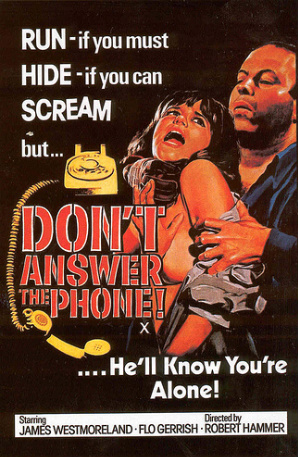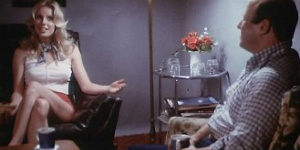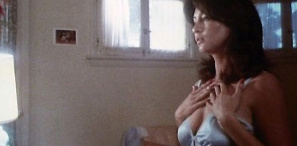
Director: Robert Hammer
Writers: Robert Hammer, Michael D. Castle
Starring: James Westmoreland, Flo Gerrish, Nicholas Worth, Ben Frank
For one reason or another, the horror genre began to revel in extreme violence during the seventies and early eighties. What had begun with Wes Craven’s The Last House on the Left and Sam Peckinpah’s Straw Dogs developed into what would become known as the rape/revenge subgenre, which would produce the likes of I Spit on Your Grave, La casa sperduta nel parco (aka House by the Edge of the Park) and Ms. 45 (many of which would find their way onto the UK’s ‘video nasty’ list during the mid-eighties). Another popular type of film would be the vigilante thriller, kicking off with Michael Winner’s Death Wish in 1974 and later followed by Rolling Thunder, Mad Max, The Exterminator and William Lustig’s Vigilante. Horror films themselves had become obsessed with serial killers, from the slasher-style boogeymen of Halloween and Friday the 13th to more sadistic and human antagonists of Maniac and Nightmare in a Damaged Brain. It would be into this climate that documentarian Robert Hammer would conceive his only feature film to date, the disturbing psycho thriller Don’t Answer the Phone.
Hammer had begun his profession as a photographer before progressing to film by shooting footage for such acts as The Steve Miller Band and Crosby, Stills and Nash. As he considered directing a feature, Hammer read through various screenplays before coming across a thriller entitled Nightline. Penned by an unknown writer named Michael Curtis and purchased for $2,500, the story told of a loner who would butcher young women and then discuss his impulses to a DJ on a radio show. Sensing the potential but realising that the concept would prove too expensive for his required budget, Hammer decided to rewrite the script over a three-week period with Michael D. Castle, who had spent the previous decade balancing unsuccessful careers as a production manager and actor. Eventually, the material would be substantially changed to the point that very little of the original premise remained.

The film was originally have to been titled The Hollywood Strangler, a reference to the Hillside Stranger who had been terrorising Los Angeles at that time (although it would later be revealed that the crimes had been committed by two men, Kenneth Bianchi and Angelo Buono). The killers would eventually be apprehended in early 1978, although by that time the script had been completed, and so Hammer chose to only use the event as a springboard for his own character and tried to avoid representing the truth too much. Despite this, he would draft in the assistance of Jon Greene, who had been working on the task force that were responsible for the actual manhunt of the Hillside Stranger and who would act as a consultant to the director. Incidentally, Greene would cameo in the movie as a policeman, just as he would in later slashers such as New Year’s Evil and Maniac Cop. Michael Towers, the executive producer, would eventually demand the film be retitled and would suggest Don’t Answer the Phone, primarily due to the success that When a Stranger Calls had enjoyed around the time that they were shooting. Other films with similar titles to be released within a twelve month period would be Don’t Go in the House, Don’t Go Near the Park and Don’t Go in the Woods.
For the casting of the movie, Hammer chose to audition various stage actors due to their natural performances and the fact that theatre requires more physical contact than film, and due to the way that many of the characters would be treated he wanted to make sure they could cope with the pressure. Nicholas Worth had performed in various Shakespeare productions, as well as uncredited roles in the Michael Crichton thrillers The Terminal Man and Coma. Much like Joe Spinell would do with his work on Maniac the following year, Worth would completely immerse himself in the role of the twisted serial killer of the piece, Kirk Smith. To prepare for the part, Worth would train weight train at Hammer’s home, where he would live throughout the shoot. In fact, the camouflage jacket that Smith wears in the movie was actually Hammer’s old military service jacket from when he had been in service and even still boasted his old badges.

The two principal leads, Lieutenant Chris McCabe and radio psychiatrist Dr. Lindsay Gale, would be portrayed by James Westmoreland and Flo Lawrence, respectively (although the latter would be credited under Flo Gerrish). Throughout the shoot, a love/hate relationship would develop between them, primarily due to their different approach to the material. Lawrence was an accomplished stage actress and would study her character’s motivations before stepping in front of the camera but Westmoreland, much to her annoyance, would turn up on set and ask the director what would be required of him for that particular scene. The tension between them escalated to the point that prior to shooting their love scene, Lawrence decided to eat a large onion so her breath would be unbearable, whilst Westmoreland chose not to shave so the experience would be uncomfortable for his co-star.
Designed as an exploitation film, Towers and the distribution company, Crown International, would insist on as much nudity as possible, although Hammer, whilst having no issues with bare flesh on screen, had no desire to fill the movie with gratuity for the sake of it. The opening scene would feature nurse Dale Kalberg (who had previously appeared in such titles as SexWorld and Mistress of the Apes) being brutally strangled in her home, although a continuity error is noticeable as she is seen to remove her underwear but when she is attacked they are visible up her skirt. Another victim, a model who the killer is photographing, was portrayed by Pamela Bryant, who had appeared as the Playmate of the Month in the April 1978 issue of adult magazine Playboy. Bryant had no issues regarding the nudity but her scenes were rushed as she had to catch a plane. Paula Warner, whose character would also be murdered in her home, had initially been reluctant to appear topless, but during filming she became more adventurous and eventually agreed.

Like many low budget efforts of the era, Don’t Answer the Phone was produced in a very guerilla filmmaking style, with the director shooting on location around Los Angeles without permits or permission. Often one of his crew members would distract enquiring police officers long enough for Hammer to complete a scene. For the sequences in the police station, an abandoned post office was used, in which a generator would be brought in to provide electricity for the two days that were required. This approach to directing was mostly due to budgetary funds and the strict eighteen-day shoot that they were forced to overcome, although Hammer’s background in shooting documentaries would have proved useful whilst having to think on his feet. A nationwide oil shortage which had stemmed from conflicts in the Middle East also added further complications to the already troublesome experience.
Having trained under karate teacher Ed Parker, Hammer was able to choreograph some of the fight scenes, most notably one when Stan Haze was to attack Worth with a knife, only for his co-star to disable him and then smash a bottle over his head. Unfortunately, the sugar glass bottles that the crew had obtained were the thickest on the market and, due to Haze being bald, shards of the fake glass cut into the top of his head, resulting in his character having to wear a bandage later in the film. When Don’t Answer the Phone was released on February 29 1980, the movie was met with criticism, mostly due to accusations of misogyny and its portrayal of a Vietnam vet. Hammer himself was disappointed with the end result and, after several other projects fell through, retired from the film industry. Twenty five years later, he was contacted by Video Watchdog writer Shane M. Dallmann to provide a commentary for an uncut DVD by BCI Eclipse. This would be the first time since its release that the film would be available uncensored and Hammer, who had not watched it for over two decades, was surprised by how much he actually enjoyed it. He has stated, though, that by today’s standards the film is too tame and if he was ever given the chance to remake it he would make it far bloodier take the concept much further.


6 Responses to Don’t Answer the Phone (1980)